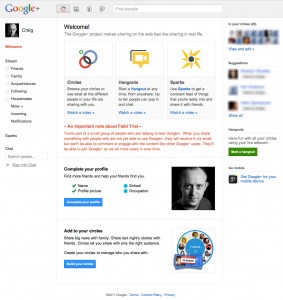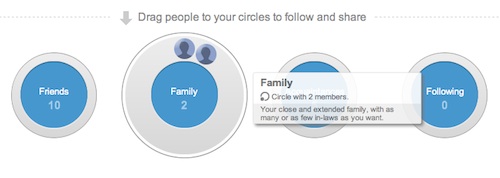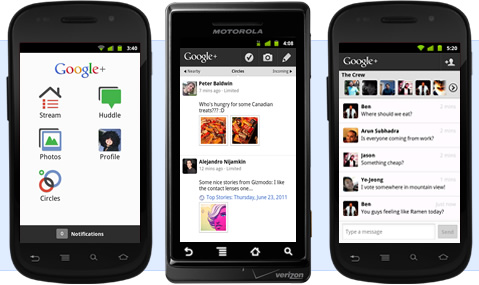
There’s been a lot of hoopla since Google+ went live last week. As with previous Google products, the only way to try it out before its public release is to get an invite. Those have become so coveted that invitations even popped up for sale on eBay before Google stopped allowing invites altogether. But is the hype justified? And is this the foray into social media that could prove successful for Google and make up for its failed previous attempts?
At TechCentral, we’ve been using Google+ since we secured invitations last week, and one thing is clear to us: it’s Google’s best attempt at social media to date. Yes, it does look a lot like Facebook, but thankfully without the advertisements — for now at least – and with a ubiquitous “+1” button instead of a “Like” button. But it’s not the fact that it looks like Facebook that makes it a potential winner. Rather, it’s what it offers that Facebook doesn’t, and how it offers it.
What it provides is easy-to-navigate control over what you share with whom, courtesy of a feature called Circles. Essentially simply a way to group your contacts, Circles has an intuitive drag-and-drop interface, and allows users to ensure they only share content with the people they want to. Moreover, circles are never shared, so if you have one called “People who annoy me but might get me out of jail one day” at least its members will never know that’s what you think of them.

It’s also possible to add someone to a Circle without them doing likewise, so you can follow someone in the Twitter sense rather than having to reciprocate a la Facebook. Thankfully, you can add people to more than one circle, so that colleague-cum-drinking buddy can get both your personal and work-related posts.
Circles is certainly the feature Google hopes will turn Google+ into a thriving social network, and it really is the best approach to the way people actually want to share information that we’ve seen to date. But Circles does have its flaws. Most importantly, the suggested contact list is populated from your Gmail contact book, which is fine if you’re an Android user and all of your contacts are up to date, but less so if you’re not and they aren’t.
Fortunately, this time around Google didn’t automatically add all contacts from users’ Gmail accounts to its social platform (as happened when the disastrous Google Buzz was launched). But it would still be great to be able to import contacts from elsewhere. No doubt this, along with other minor failings, will be addressed in updates. After all, Google+ is only in its infancy so there are bound to be a few kinks.
Perhaps the best feature of Circles is that it’s possible to opt to prevent people in your Circles from re-sharing content you’ve shared with them. Still, for the paranoid there may be other privacy concerns. Like Facebook, Google+ wants to encourage people to share as much information as possible, including making your Google+ profile public, if you’ll allow it.
But, unlike Facebook, cranking up your Google+ privacy settings is a fairly straightforward process. The settings page includes your Google account information, Google+ settings, and a tab called “Data Liberation” that allows you to export things like your contacts and Circles information and flips Facebook the finger in the process.
Of course, like Facebook, Google hopes you’ll use its social media service so it can glean even more information about you and your browsing habits, and tailor your search results, and the adverts you see, accordingly.

Furthermore, a look at Google’s terms of service suggests that “by submitting, posting or displaying the content you give Google a perpetual, irrevocable, worldwide, royalty-free, and nonexclusive license to reproduce, adapt, modify, translate, publish, publicly perform, publicly display and distribute any content which you submit, post or display on or through the services”.
So if you are, say, a professional photographer, you may want to think twice before using Google+’s photo sharing capabilities. But then, Facebook’s terms of service are equally draconian and alarming. For most users, however, this isn’t anything to be worried about, unless they have something to hide — or plan to in the future.
Photo sharing
Photo sharing on Google+ is a doddle, and uses the company’s Picasa platform. The Picasa name is expected to fall away at the end of the month, along with all private Google accounts, in what is clearly part of Google’s long-term strategy to consolidate its products with Google+ at the centre.
Google+’s equivalent of Facebook’s feed is called “Stream”, and it’s possible to view everything, or only content from specific circles. Similarly, when posting content, you can decide exactly which of your circles get to see it. As with its biggest competitor, posting to Google+ is straightforward, as is attaching images, videos, links or your location (the last of these is facilitated by Google’s Latitude platform).

Aside from Circles, the most talked about features of Google+ are its group video chat feature “Hangouts” and its personalised Google Reader-like content aggregator “Sparks”.
Hangouts allows users to create multiparty video chats, collectively watch YouTube videos, send instant messages, and basically do the sorts of things Skype offers, albeit with the obligatory YouTube punt (it is a Google product after all).
Reports suggest that Hangouts is incredibly bandwidth intensive, but then that’s to be expected. So, we’d advise against lengthy video chats when using 3G or any uncapped connection for that matter.
Google+ also incorporates Google Talk in its sidebar, much like it is in Gmail, except that in this iteration it’s simply called Chat. As with Google Talk in Gmail, it’s possible to make and receive video calls from Google+, although curiously there isn’t the option to call phones as there is in Gmail.
Sparks, meanwhile, seems far less refined than other Google+ features. Essentially an aggregator that uses all of that information Google has about you to suggest content you might like, Sparks is somewhat underwhelming in that the content it suggested to us was neither particularly relevant nor interesting. Still, it’s early days, and we have no doubt that the more time we spend on Google+ the better its suggestions will get.
The Facebook challenge
That’s really the key issue with Google+: time. Can it get people to spend more time on it, or just in Google’s universe in general, and less time on Facebook? After all, Google isn’t just worried that it’s lost ground in the social media race, it’s worried that the more people do everything via Facebook, the less data it can collect, collate, and analyse about them.
Google+ has one immediate advantage over Facebook — its number of users. Facebook may have hundreds of millions, but if you add together all of the users of Google’s search, mail, calendar, apps, documents, reader and other services, Google still wins the popularity contest by far. And that’s where the real potential of Google+ lies.
Google+ promotional video (via YouTube):
Google in recent weeks began making changes to some of its products, the most noticeable of which was the black services bar at the top of Gmail and Docs (curiously, it hasn’t yet made it to Calendar or Reader). After signing up to Google+, that bar includes a link to the service at the far left, and your name (with a drop down to access your account details, privacy settings and the like) alongside a status block on the right.
Every time you get a Google+ notification it shows up here. Furthermore, say someone comments on something you post, clicking the notification brings up the comment (along with any previous comments and the original post) in the notification window itself. Thus, there’s no need to log into Google+ to interact with it.
It’s the seamless integration of Google+ that’s most likely to drive uptake from users. If you use any Google product, maintaining a Google+ account is fairly effortless, and that’s surely essential if Google hopes to encourage people to use yet another social media service.
Going mobile
As the company behind the Android operating system, it’s no surprise that when Google+ launched there was an Android app ready and waiting. Google knows that the battle for the Web isn’t just about desktops and laptops anymore. It’s also about mobile devices, and the company has produced a stunning app to support the service.

The Google+ mobile app has all of the functionality of the browser version with the exception of the video chat feature, Hangouts. Instead, it has “Huddle”, which is Google’s answer to BlackBerry’s messenger, Whatsapp, iMessage and like. It supports multi-person text chats, and there are probably plans afoot to include video and give Skype palpitations in the process.
A number of sources suggest Google has already submitted iPhone and iPad apps to Apple’s App Store for approval, so it shouldn’t be long before it’s available on the iOS platform, unless of course Apple chooses to sulk and drag its heels.
Can it succeed?
Since it’s launch last week there’s been a lot of talk about whether or not Google+ will be able to lure some of Facebook’s legion of users into changing sides. While its certainly not going to result in a mass Facebook exodus, the sheer pervasiveness of Google’s services and the manner in which Google+ has been integrated into them suggests that this is the company’s best social effort yet, and one that is unlikely to suffer the same embarrassing fate as its previous attempts.
Unlike Buzz, we’re pretty sure Google+ will still be around in a year’s time. It will be even better looking, and more thoroughly integrated with Google’s ecosystem than it is now. And considering how good it is already, the future of Google+ looks to be very exciting indeed.
Of course, there’s no reason to think that Facebook is going to sit back and let Google shamelessly mimic and outdo it. Facebook has been feeding the rumour mill with talk of a big update.
Also, MySpace didn’t only stagnate because Facebook offered a better social media experience. It failed to keep up by innovating. Google was miles behind in the social media sphere until last week, but with Google+ it’s taken a quantum leap forward again.
Make no mistake, Google+ is no Twitter replacement, nor is it a Facebook killer. It’s new, and thus it’s desirable, so it really is going to be a matter of waiting for the novelty to wear off, and seeing how many users adopt the service before carving any headstones for its competitors. — Craig Wilson, TechCentral
- Subscribe to our free daily newsletter
- Follow us on Twitter or on Facebook




